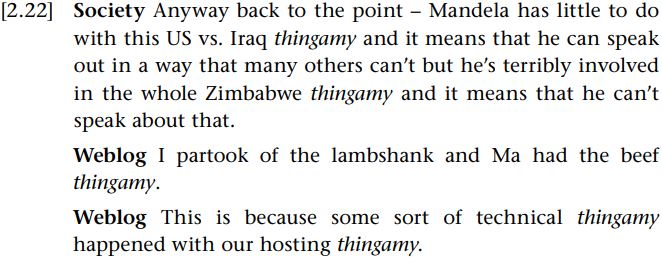


 Grammar
Grammar
 Tenses
Tenses
 Present
Present
 Past
Past
 Future
Future
 Parts Of Speech
Parts Of Speech
 Nouns
Nouns
 Verbs
Verbs
 Adverbs
Adverbs
 Adjectives
Adjectives
 Pronouns
Pronouns
 Pre Position
Pre Position
 Preposition by function
Preposition by function 
 Preposition by construction
Preposition by construction
 Conjunctions
Conjunctions
 Interjections
Interjections
 Grammar Rules
Grammar Rules
 Linguistics
Linguistics
 Semantics
Semantics
 Pragmatics
Pragmatics
 Reading Comprehension
Reading Comprehension|
Read More
Date: 13-5-2022
Date: 4-5-2022
Date: 26-4-2022
|
Reflection: Recognitional deixis or thingamy
A specific phenomenon that it is strongly dependent on common ground concerns nominal expressions such as thingamy, thingamajig, thingamabob, whojar, whatsit, what’s-his-name, what-d’you-call-it, and you-know-what. Such expressions, unlike the definite noun phrases discussed earlier, provide little descriptive information to help one work out what is being talked about. Yet, in the shared context of a dinner, an expression such as thingamy is likely to be taken as a reference to the pepper mill on the table, and was equally likely to have been used in the expectation that this reference would be assigned. Recognitional deixis is a label coined by Enfield (2003) for such items. It acknowledges that they behave like deictic expressions picking out items relative to the speaker’s here and now, but also that they rely heavily on common ground to be successfully “recognized”.
Why might we use such words? Consider these examples of recent usage of thingamy taken from the Oxford English Corpus:

Although you do not have access to the full context, it is quite easy to see that they are often used in contexts where specialized lexis would be required (e.g. technical items or specialized cuisine), or where there may be difficulty in identifying an appropriate word (e.g. dealing with the sensitivities of a diplomatic wrangle), or where there are restrictions on the obvious term (e.g. labelling a cleaning product without actually using the trademark name). In context, it is highly likely that these will present few difficulties, because the participants have a common ground. Additionally, it is not the case that such expressions present participants with no descriptive information at all; in fact, they offer constraints on interpretations. This point is spelt out by Enfield (2003). He suggests, for example, that the speaker’s message in using what’s-his-name could be defined as: someone (male); I can’t say this person’s name now; by saying what’s-his-name I think you’ll know who I’m thinking of (2003:105). This contrasts with, for example, you-know-what, which “may have both ‘avoidance’ and ‘conspiratorial’ functions, whereby a speaker deliberately avoids saying a certain word, either to prevent potentially overhearing third parties from understanding, and/or to create exclusive air between interlocutors” (2003:106).
|
|
|
|
التوتر والسرطان.. علماء يحذرون من "صلة خطيرة"
|
|
|
|
|
|
|
مرآة السيارة: مدى دقة عكسها للصورة الصحيحة
|
|
|
|
|
|
|
نحو شراكة وطنية متكاملة.. الأمين العام للعتبة الحسينية يبحث مع وكيل وزارة الخارجية آفاق التعاون المؤسسي
|
|
|